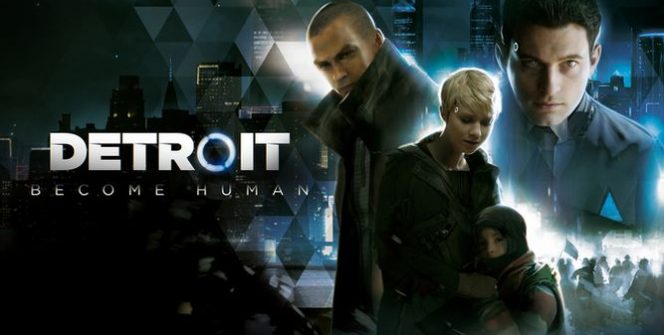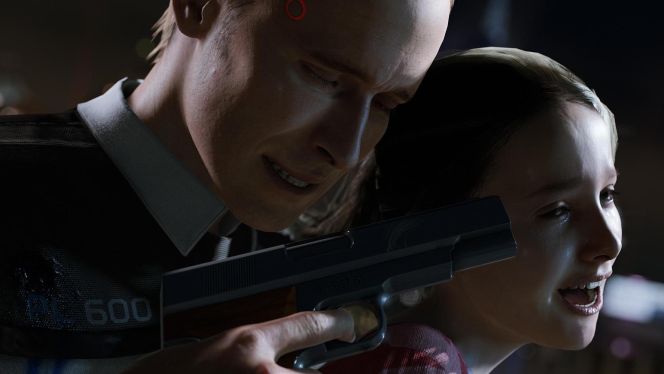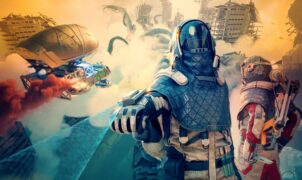REVIEW – After hunting a serial killer in Heavy Rain and running from the CIA with a dangerous girl with supernatural gifts in the Stephen King-like Beyond Two Souls, David Cage and Quantic Dream are back again with a tale of androids revolting against humans in the futuristic city of Detroit. Cage’s latest game owns a lot to android movies like Blade Runner (2049), AI, Terminator 2 or Ex Machina, but it also found its own story and mesmerizing, futuristic world. Welcome to Detroit: Become Human, where you will lead three different androids with the three different paths and three different goals, but living in the same world of Detroit.
“When men, even if they do not know it, must meet one day, anything can happen to each of them, and they can follow divergent paths. At the appointed day, ineluctably, they will be united in the red circle. ” This „Buddha quote,” made up by French director Jean-Pierre Melville for his film noir movie The Red Circle actually sums up perfectly what happens in the futuristic tale of Detroit: Become Human. In the game, we lead three different Androids, with a different past, having their own personal problems and each one having a dramatic path in this futuristic city of Detroit.
Connor is a robot that acts as a detective, while Kara and Markus help in little mundane domestic tasks. Markus seems to be the more fortunate one as he’s the servant of a rich, famous and intelligent painter, Carl Manfred (acted and voiced by Lance Henriksen, who played androids in Aliens and Alien 3 in the eighties), Kara, on the other hand, must serve an alcoholic and aggressive human father who resorts to domestic violence against his own daughter. During the game, we have to make often dramatic choices, which alter the outcome of the story in several, different ways.
You’ll like them
One of the game’s and the story’s strongest points is how you gradually grow attached to its main characters – even if you play differently. Connor acts as an idealistic, optimistic, smart young detective, always trying to decipher the case and his human partner, the often cynical and burnt-out Hank Anderson as well. Markus becomes the leader of the group of androids, a true revolutionist and either by pacifist or aggressive means fights humans – even if you chose the former, he’ll remain a sympathetic hero. Kara is the “ingenue” of the story: while she’s running with Alice through the city, she’ll become… well, not “human”, but she will develop the humanlike emotions of a mother.
The storyline with different branches is genuinely excellent, and even if the dialogues themselves are sometimes a bit cheesy or clichéd, I honestly want to replay the game again (we already playing it with Aniko on her account).
“The problem is choice” (The Matrix)
All the characters have a well-drawn personality by the writers of the game, in which, moreover, we can intervene with our decisions. Each chapter of the title is built like a gigantic tree full of branches to cover. It is a tree dotted with scenes of action, exploration, and puzzles that act as a trunk, as I will explain later, but we choose our path through a whole tangle of very different alternatives. “The problem is choice” – said Neo at the end of The Matrix, meaning having a free will to chose your own path is deeply human. Ironically, here it’s the essence of the game about choices the Androids are making.
Maybe in a previous game of David Cage, you felt that there was a certain “trap” as to how some of those results were formulated since sometimes, for example, Heavy Rain sometimes took you where he wanted more than where we wanted to go… That does not happen in the game that concerns us, where it is really us who are deciding the fate of its three protagonists and, often, also of many other characters.
At the end of each of these chapters, in fact, we have the option of seeing a very detailed graph of what our path has been like, and of what alternatives we have set aside. You can look at it in detail to face the game a second time or repeat a level where you want to try something, or you can ignore it and not know all those options. As I told you at the beginning of the text, Detroit is not in the habit of judging us, but it does give you the opportunity to compare yourself with what other people have done. That gigantic diagram that represents what has happened, if we want it, allows us to see also the percentages in all the nodes of how many people have inclined for each side. Is this a form of valuation? Personally, I do not believe it; I do not have the habit of thinking that what most people do is the right thing to do. However, of course, it is interesting. It has made me wish more than once that the end of the chapter would come to know what other people had done in this or that situation, and it has often made me wonder about the empathy of others or my own, depending on whether they coincided options and others. A fascinating work of anthropological company that we had already seen in some other game, but never with this level of depth.
Our acts define us
Having already made it clear that the most important thing about Detroit: Become Human is the story, that does not mean there are not many things to do around it. To say that it is a movie is very unfair, but to define it as a strongly interactive film would be much closer to what they seek (and get) to offer from this team based in Paris. That is what they have tried since their second video game, Fahrenheit, and it is a formula that I think they have managed to refine as never before on this occasion. It is not only the roundest game in the plot department that has been made so far, but it is also the one that has the most propped up sense of rhythm and its playable dynamics.
Make no mistake; if you did not like the schemes of the previous games of this company, this title would not convince you either. Many of the most important moments are defined with dialogues where we choose what to say or with dilemmas where we choose what to do. Detroit is better, is more varied by incorporating new playable mechanics and is more polished than the previous ones in all those aspects, but in essence, it is still relatively similar. Yes, there are also action scenes again as there were in the previous ones and even some other surprising flirtation with stealth, but they seem mere distractions to inject a point of emotion to the campaign. All are resolved with QuickTime Events with choices to choose what our character will do next, and it will never allow us direct intervention. Of course, missing a combination of buttons can be critical to the progress of the adventure and will cause unexpected derivations in the story. However, in the company, they have also thought about the more inexperienced people, and there are two levels of difficulty, one that generates some challenge in that type of sequences, and another much more accessible for those who are interested in enjoying the story.
Other dynamics work better than the action, equally simple but much more effective. For example, exploration is a capital point of Detroit: Become Human. It is the Quantic Dream game that has the most varied and great scenarios that we have seen to date, and it helps a little to get rid of that feeling of being constricted in very tight sets that we might have in some of the previous games. Do not think that this is a sandbox, far from it, but we can move with relative freedom through maps that sometimes include several streets or inside a house and its surroundings. We can never go too far from our goals, a barrier a bit rude prevents us, but it is enough to discover things that give us more information about your world or even some ways that make history progresses through unexpected means.
“You are the detective, so detect!” (Que d’os! – Jean-Patrick Manchette)
The third playable way used by Detroit is the puzzle. All the characters have one, but the one who lays the most in it is Connor since – conveniently – he is a detective. This way allows David Cage to explore some very interesting elements to make the adventure entertaining and fun, making us feel a certain capacity for pleasant satisfactory discovery. Investigating murders is always effective in a video game, but with the fascinating tools of robots, it is even more effective. It strikes me, and I consider it also very practical, how some combat sequences are also constructed as puzzles. Time stops, and we are offered several alternatives. In that lapse of time, taking a look around is something that discovers different ways of executing a certain scene of action and that, if we are sufficiently observant, you can make us optimize your results. It is a good way to combat the absence of direct intervention.
Building Detroit
If we had to define the graphics section of Detroit: Become Human with one word, that should be the following: realism. If you’ve seen many movies, you’ve probably noticed that most conversation scenes are built with close-ups of the speakers. Moreover, in the video game, there are many dialogues … Many! David Cage does not want to make films (or maybe he does?), but what seems clear is that he wants to capture his ideas with a very cinematographic staging. That’s why the plane-contra plane is plentiful in a choice of perspectives that Heavy Rain, launched eight years ago, might not have endured as well as this new game does.
Here the faces of the characters are, simply, hallucinating. It has become a hallmark of Sony’s internal companies to achieve amazing quality in facial expressions and face finishing, and you can see accompanying the review several images that testify to the enormous quality or see everything in motion in the video analysis of Detroit: Become Human. Both the images and the video cuts show that one of the efforts of Quantic Dream has been to make it as easy as possible to establish ties of empathy with the protagonists, and also make the plot and the world very compelling.
The scenarios also present an outstanding finish. I have already told you before that the exploration is somewhat limited because the title does not allow you to get too far away from its main objectives, but it is feasible to take a good look at them and not only to rejoice the eyes with their great finish but to feel inside. That helps some great lighting techniques and a work for textures detailing really good, which shines whenever it can.
When we move through the sets is when we really see the characters move, and we test some animations which have been one of the traditional workhorses of the French studio. They have often been accused that the movements of their characters are somewhat robotic. Here, all the protagonists are androids, which gives some meaning to some movements somewhat rigid and determined chains of very “inhuman” actions.
Let’s get technical
Moreover, it is because Detroit: Become Human has a level of detail and fantastic definition thanks to great work with checkerboard rendering. The thing is that the standard PS4 and PS4 Pro models are unable to move a game of these characteristics to 2160p, although a Quantic Dream employee said that Detroit: Become Human would support native 4K a few weeks ago and Sony had to deny it, providing confusion in a maneuver of unusual awkwardness. For that, techniques that deceive the spectator are used, and they do amaze us. The result offered by the title is extraordinary with this technique that divides the screen into cells as if it were a chessboard to render half and “invent” the other 50%. It is a maneuver that would not support any technical test, but the human eye provides a very estimable quality as had already shown at the time the phenomenal finish of the brilliant Horizon: Zero Dawn or the most recent God of War. Apparently, it has become a standard for Sony exclusive and, in the absence of more power in the two machines, it seems a good solution to still make awesome graphics.
In terms of sound there is absolutely nothing to reproach the video game. Quantic Dream has always been a company that has shown a particular interest for the music, in fact for Fahrenheit they hired the cult composer Angelo Badalamenti, at a time when film musicians did not play as much in video games as they do now. To give identity to the three characters, there are three different soundtracks (each of them signed by a composer) and formed by several very identifying themes of the personality and the circumstances of each one. For the rest, the audio effects are as fantastic as we expect from an overproduction of this caliber.
Become Quantic Dream
Detroit: Become Human is still a 100% Quantic Dream game, so it has all the manners and tics of the David Cage games and it will not deter those who accuse them of lack of interaction. However, it is difficult to find something as powerful in its genre as what it has achieved this time. This PS4 video game is fascinating and it’s almost movie quality, but I do not think that it neglects at all an argument full of hard decisions to make either, while it approaches difficult issues with seriousness and good work. In my opinion, it is the best game so far by the creators of Heavy Rain.
-BadSector-
Pro:
+ A great story and really well told
+ The feeling of having control and making decisions that affect the narrative
+ Graphically it is an amazing game. Almost a true movie
Against:
– The QuickTime Events have been reduced, but they are still very present
– More puzzles more situations for the exploration would have been good
– Some cheesy dialogues and clichés
Publisher: Sony Interactive Entertainment
Developer: Quantic Dream
Genre: Adventure, exploration, action
Release date: May 25, 2018
Detroit: Become Human
Gameplay - 7.8
Graphics - 9.2
Story - 8.1
Music/Audio - 8.4
Ambiance - 8.9
8.5
EXCELLENT
Detroit: Become Human is still a 100% Quantic Dream game, so it has all the manners and tics of the David Cage games and it will not deter those who accuse them of lack of interaction. However, it is difficult to find something as powerful in its genre as what it has achieved this time. This PS4 video game is fascinating and it’s almost movie quality, but I do not think that it neglects at all an argument full of hard decisions to make either, while it approaches difficult issues with seriousness and good work. In my opinion, it is the best game so far by the creators of Heavy Rain.




















Leave a Reply